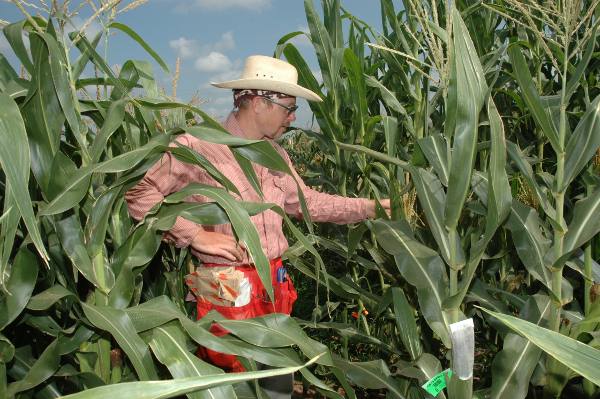
Virtually all the corn grown in Texas was developed in the Midwest. And that’s not necessarily a bad thing — hybrids developed in the Corn Belt yield well, and most of them stand up fairly well in Texas summers.
It makes sense, too, that the major corn seed companies would concentrate efforts where most of the corn is grown, and market those hybrids to the rest of the corn-producing areas.
But it also makes sense, says Texas AgriLife Research Corn Breeder Seth Murray, to develop hybrids for a specific geography and for conditions that are unique and more prevalent in that geography.
Public sector plant breeding can create those hybrids, he says. At the Texas A&M research farm at College Station, Murray has created 3,000 to 4,000 germplasm lines to screen for conditions prevalent in central and south Texas. Drought tolerance and aflatoxin resistance are primary goals, he says.
“We also screen for yield and other desirable traits. We have shown that corn developed in the region where it will be grown can make a difference. Currently, Texas farmers have few choices other than Midwestern derived hybrids. We’re trying to offer them more choices.”
The challenge for most seed companies, he says, is that the Texas market — 2 million acres a year — isn’t big enough to justify a major breeding investment.
“At Texas A&M we began breeding with a good collection of germplasm from around the world, including Mexico, Argentina, and Bolivia, as well as from the Midwest.”
He says the Central and South America options may be good targets for drought and aflatoxin tolerance. An Argentine variety has shown some good population traits, but lacks the aflatoxin resistance he’s seeking.
Murray was recently recognized with the 2013 NAPB Early Career Award by the National Association of Plant Breeders and Plant Breeding Coordinating Committee. See the story at http://bit.ly/1anTebB
“We’ve pared screening down to the 70 best lines,” Murray says. “These are good some years, in some locations, but we haven’t seen enough data to commercialize them — yet.”
Long Process
That’s a long, arduous process. “Breeding corn in Texas is difficult,” he says. “With temperatures greater than 90 degrees, we often see poor seed set. In Iowa and Illinois, they often get seed set of 200 kernels; we get much less than that — heat kills the pollen.” He says lines developed in central Texas pollinate better than commercial lines.
Corn is also photoperiod sensitive. “We can produce seed here, but much of it flowers too late. That will be a real challenge going forward. A late-maturing hybrid might be a better choice in some areas of Texas, but those lines are also more susceptible to aflatoxin, since they mature during more stressful hot weather.”
If you are enjoying reading this article, please check out Southwest Farm Press Daily and receive the latest news right to your inbox.
Aflatoxin is the prime focus of the 70 lines on which he’s focusing. “We previously released three lines with very good aflatoxin resistance,” he says. “With two of them, yields were unacceptable, but we’ve come a long way.”
He’s looked at some lines that yield “as good or better than commercial hybrids, but we need to fix yield potential before we release anything to growers.”
Murray says leaves make a difference in drought tolerance. “We have corn with leaves that are waxy and hold water better than flatter leaves.”
Ear position is also important. Midwest corn hybrids have ears that stand upright, which helps the corn dry down. “But here, we get moisture under the husk and onto the grain. We want tight husks on ears that droop down. Corn ears used to do that, and we select for that trait so the ears will shed water.”
Murray says drought tolerance and aflatoxin are somewhat related. “Aspergillus is not a strong pathogen, but it gets a better foothold on stressed corn.” Total resistance is highly unlikely, he says. “No one has identified a completely aflatoxin-resistant variety,” but he’s hoping to improve the odds.
Aflatoxin contamination in some situations can reach above 2,000 parts per billion. Anything above 20 ppb can’t be sold for human consumption or for dairy feed. In Texas, anything above anything above 300 ppb can’t be sold and anything over 500 ppb has to be destroyed.
In a bad aflatoxin year, levels may push 3,000 to 5,000 ppb in inoculated non-resistant varieties. Resistance could lower that to 100 ppb.
“But breeding isn’t the only answer,” Murray says. “Newly available atoxigenic strains of the Aspergillus fungus have been used as a biological management tool by out-competing the Aspergillus flavus (toxic) strain.” Average control with those products has been about 70 percent, he says.
A combination of breeding and continued study of other control measures will be essential to reduce contamination.
Midwest corn growers may become more interested in aflatoxin resistance, following a disastrous drought year in 2012. “Aflatoxin and drought are becoming more common in the Midwest,” Murray says. “It’s becoming relevant in corn country.”
A big challenge is to develop a hybrid and then get a commercial company to add it to their breeding lines. Independent companies, such as B-H Genetics and Golden Acres Genetics, which are located in Texas, would be appropriate partners, he says. The next step is grower acceptance. “Growers have a lot of brand loyalty. They may not demand something better, such as aflatoxin resistance. We’re trying to offer more choices and make a difference.”
He also shares information and products with Texas A&M counterpart Dr. Wenwei Xu at the Lubbock Research and Extension Center.
It’s a long road from screening germplasm to releasing a new variety, Murray says. “With the best support, we expect at least seven years to get a new variety.” A 10- to 15-year stretch is more likely.” Support from the Texas Corn Producers Board and the USDA has been critical to his breeding efforts.
Public breeding work will be an integral part of making certain corn growers in the future have what they need to produce profitable yields, he says. “In the first year of the Dust Bowl, folks probably thought it was just a freak thing. By the time they understood it, it was too late to develop new varieties.”
Murray and other plant breeders are hoping they can provide farmers necessary tools before they must have them.
You may also like:
Hibetter breeding togher wheat yields and follow genome mapping?
In spite of new study, Texas corn specialist says state corn production…
About the Author(s)
You May Also Like






